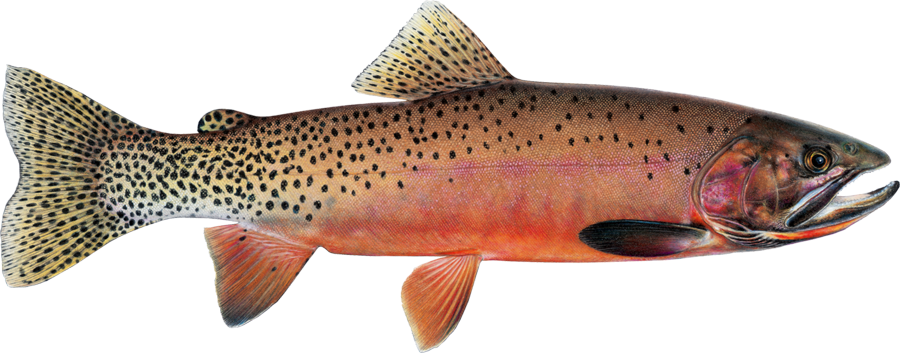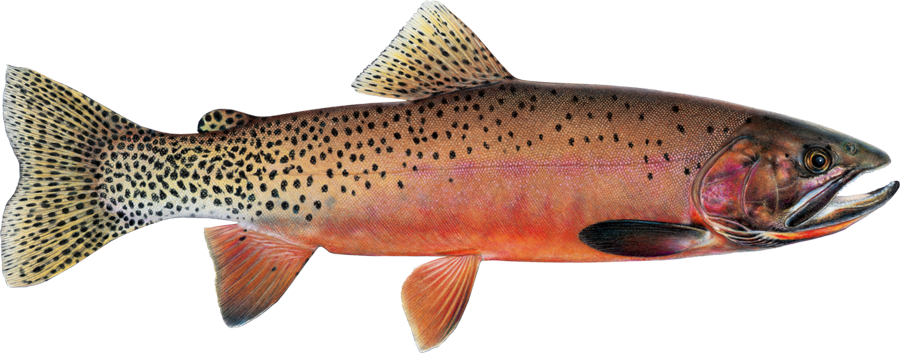The Four C's: Clean
Quality Aquatic Habitat is Clean
Clean aquatic habitat consists of high-quality water with clean gravel in riffles and low levels of fine sediment. Bull trout, westslope cutthroat trout, and whitefish require clean gravels for spawning. Many aquatic insects also need clean gravels. Increased sediment delivery to drainages—beyond what naturally occurs in an undisturbed stream—adversely affects salmonid habitat and the survival of incubating eggs. Pollutants like cow manure can also harm fish and insects. And of course, people need clean water for drinking, swimming, and other uses.
Sediment—soil and silt that washes into the stream—smothers trout eggs, and kills them. Many aquatic insects also need clean gravels. The image above shows the impact of sediment on trout eggs. You can use the dots to toggle between conditions: a stream with clean water and healthy trout eggs and a stream full of sediment where the trout eggs have suffocated and died.
What Causes Excess Sediment?
Problem |
Solution |
|---|---|
|
Driving through streams (even small streams). |
Keep vehicles of all kinds out of streams. Stay on roads and cross water only on bridges and culverts. |
|
Livestock grazing in riparian areas that is too early in the season, too long, too much, or too often. |
Distribute livestock better using off-stream water developments, salt, fencing and herding; control the intensity and timing of grazing in riparian zones; and add more rest to the grazing cycle. |
|
Too many roads and poorly planned roads. |
Close unneeded roads and revegetate the retired road bed. Improve poorly planned roads. |
|
Loss of riparian vegetation. |
Maintain adequate riparian buffers. Avoid land clearing, logging, and cropping within the riparian zone. |
|
Livestock and human waste. |
Keep livestock out of wet areas and away from stream banks. Properly dispose of human wastes. |
If you keep it clean, you'll keep trout in the stream.

The Four C's: Clean
Quality Aquatic Habitat is Clean
Clean aquatic habitat consists of high-quality water with clean gravel in riffles and low levels of fine sediment. Bull trout, westslope cutthroat trout, and whitefish require clean gravels for spawning. Many aquatic insects also need clean gravels. Increased sediment delivery to drainages—beyond what naturally occurs in an undisturbed stream—adversely affects salmonid habitat and the survival of incubating eggs. Pollutants like cow manure can also harm fish and insects. And of course, people need clean water for drinking, swimming, and other uses.
Sediment—soil and silt that washes into the stream—smothers trout eggs, and kills them. Many aquatic insects also need clean gravels. The image above shows the impact of sediment on trout eggs. You can use the dots to toggle between conditions: a stream with clean water and healthy trout eggs and a stream full of sediment where the trout eggs have suffocated and died.
What Causes Excess Sediment?
Problem |
Solution |
|---|---|
|
Driving through streams (even small streams). |
Keep vehicles of all kinds out of streams. Stay on roads and cross water only on bridges and culverts. |
|
Livestock grazing in riparian areas that is too early in the season, too long, too much, or too often. |
Distribute livestock better using off-stream water developments, salt, fencing and herding; control the intensity and timing of grazing in riparian zones; and add more rest to the grazing cycle. |
|
Too many roads and poorly planned roads. |
Close unneeded roads and revegetate the retired road bed. Improve poorly planned roads. |
|
Loss of riparian vegetation (vegetation that grows along the stream). |
Maintain adequate riparian buffers. Avoid land clearing, logging, and cropping within the riparian zone. |
|
Livestock and human waste entering the stream or floodplain |
Keep livestock out of wet areas and away from stream banks. Properly dispose of human wastes. |
If you keep it clean, you'll keep trout in the stream.




